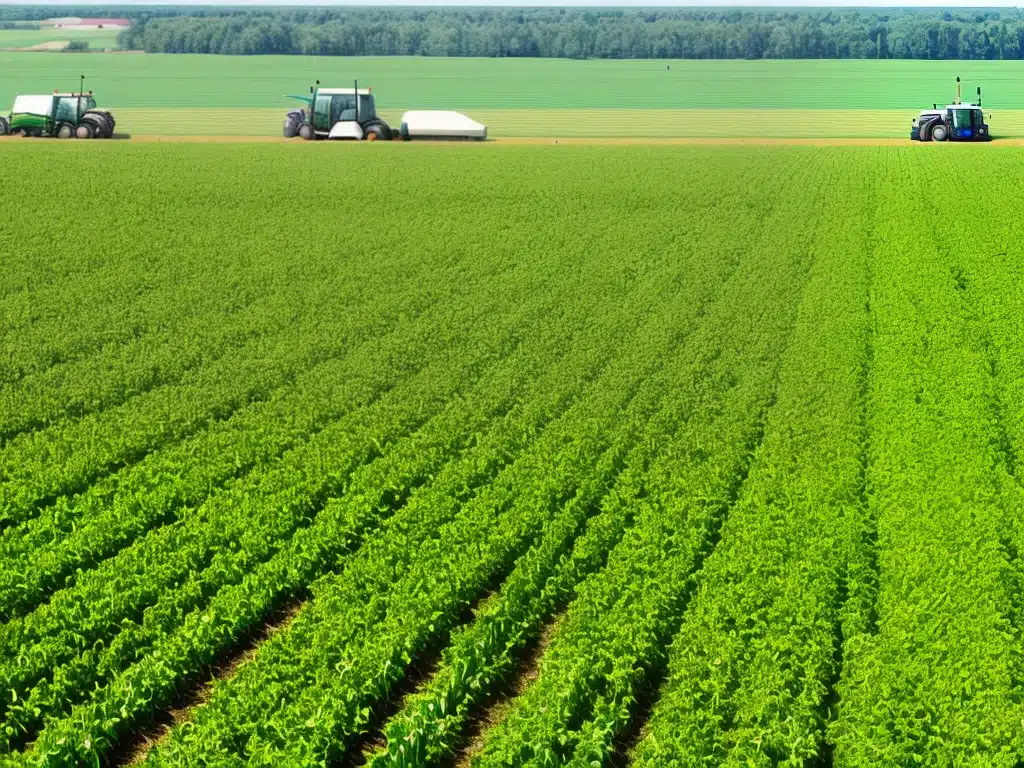
IoT in Agriculture: Maximizing Efficiency and Yields
Introduction
Agriculture is a crucial industry that feeds the world’s growing population. However, it faces numerous challenges such as climate change, soil erosion, water scarcity, and inefficiency. This is where Internet of Things (IoT) comes in. IoT refers to the network of physical objects embedded with sensors, software, and connectivity that enables data collection and analysis. Implementing IoT in agriculture can help maximize efficiency, increase yields, and build sustainability.
In this article, I will provide an in-depth look at how IoT is transforming the agriculture industry. I will cover the major applications of IoT in agriculture, the benefits it provides, real-world examples, and the future outlook. My goal is to showcase how IoT-enabled smart farming is optimizing agricultural operations.
Major Applications of IoT in Agriculture
Precision Farming
Precision farming leverages IoT sensors, GPS, robotics, and big data analytics to optimize farming operations at a granular level. Sensors monitor soil conditions, crop growth, livestock health, and environmental factors in real-time. This data gets analyzed to derive actionable insights about irrigation, fertilizer use, pest control, and more. As a result, inputs are applied only where and when needed to boost productivity and reduce waste.
Smart Greenhouses
In smart greenhouses, IoT systems automate climate control, irrigation, lighting, and monitoring. Sensors track temperature, humidity, soil moisture, and other parameters. Actuators and controllers adjust these variables to optimal setpoints by operating vents, lamps, sprinklers, and other equipment. This creates perfect growing conditions 24/7, leading to higher and faster crop yields.
Livestock Monitoring
IoT-enabled wearables attached to cattle, poultry, and other livestock track their movement, behavior, health, and well-being. Farmers can remotely monitor the animals in real-time and get alerts about illness, injuries, or distress. This improves care and reduces livestock mortality rates.
Farm Vehicle Tracking
Embedding IoT sensors in tractors, sprayers, and harvesters enables tracking farm vehicles. This provides insights into each vehicle’s location, fuel usage, engine performance, and maintenance needs. Farmers can then optimize routing and scheduling to save time and costs.
Cold Chain Monitoring
Perishable produce like fruits, vegetables, and meat must be stored and transported in temperature-controlled environments. IoT sensors enable real-time cold chain monitoring by tracking temperature, humidity, light, and shock throughout the supply chain. This prevents spoilage and waste.
Key Benefits of Implementing IoT in Agriculture
Increased Efficiency and Productivity
IoT automation and data-driven insights minimize human error and guesswork in decision-making. This enhances workflow efficiency, bringing productivity gains of 20-30%.
Cost Savings
Targeted use of inputs like water, fertilizers, and pesticides reduces wastage and lowers costs. Proactive equipment maintenance also avoids downtime costs. Overall, IoT saves up to 25% in operational costs.
Higher Crop Yields
Optimized growing conditions and precision farming techniques boost crop yields by 15-30% compared to traditional methods.
Better Quality Produce
Continuous monitoring and automated control over the growing environment results in higher quality, uniform, and consistent agricultural produce.
Sustainability
IoT enables judicious use of natural resources like water and land. It also reduces chemical inputs and soil compaction by equipment. This fosters agricultural sustainability.
Increased Profits
Higher yields, lower costs, minimized waste, and premium produce quality ultimately translate into increased profits for the farmer. IoT systems deliver over 15% rise in net farm income.
Real-World Examples of IoT in Agriculture
John Deere Operations Center
The John Deere Operations Center provides real-time analytics to farmers by integrating data from sensors and farm equipment. This enables monitoring crops, soil, livestock, and machinery from a centralized platform. Farmers gain actionable insights to drive decisions.
AgriWebb Farm Management Software
AgriWebb offers an intelligent IoT platform for cattle farmers. It uses real-time data from tagged livestock to optimize grazing, prevent disease, track genetic traits, and monitor animal welfare. This cattle management software has delivered increased productivity.
Teralytic Soil Sensors
Teralytic produces wireless probes that farmers can embed in their fields to monitor key soil parameters continuously. The data helps determine irrigation needs and optimize fertilizer application. Use of these IoT soil sensors has shown 10-15% increase in crop yields.
Autonomous Farming Vehicles
Brands like John Deere and Case IH are developing driverless tractors and other robotic farm equipment. These autonomous vehicles, powered by IoT sensors and AI, can plow, seed, spray, and harvest crops with high precision without human operation.
CropX Irrigation Management
CropX offers an IoT-based irrigation monitoring and control system. It uses in-field sensors and predictive analytics to determine optimum irrigation needs. By irrigating precisely when needed, the system has saved over 25% in water usage.
The Future Outlook of IoT in Agriculture
IoT is poised to transform farming and food systems worldwide. Here are some key predictions for the future:
- Wider adoption of integrated farm management platforms that converge all farm data into a single dashboard.
- Drone and satellite imagery will supplement in-field IoT sensor data for richer insights.
- Machine learning and AI will better predict outcomes like crop diseases, yield estimates, and demand forecasting.
- Robotics and automation will carry out more tedious and dangerous tasks on the farm.
- Transition to hyper-local and transparent sustainable farming based on IoT traceability.
- Emergence of urban IoT-based smart farms and hydroponics systems.
- Increased regulation and cybersecurity measures for agricultural IoT systems.
Conclusion
Implementation of IoT-based smart systems is modernizing farms and ushering the era of precision agriculture. IoT unlocks data-driven insights to optimize growing conditions, automate operations, conserve resources, and maximize yields. With solutions spanning precision farming, smart greenhouses, livestock monitoring, farm vehicle tracking, and cold chain management; IoT is transforming agriculture to be efficient, productive, and sustainable. While there are still challenges around connectivity, interoperability, costs, and security – the benefits outweigh the limitations. IoT in agriculture has a bright future as it continues to evolve through technological innovation.












